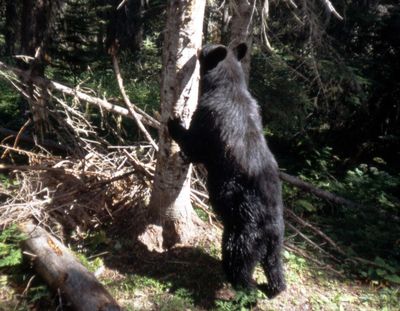Learning to live with wildlife

For many, seeing deer, turkeys and even the occasional black bear is one of the perks of living in the Inland Northwest.
But living close to wildlife requires some human adaptation.
“I think the biggest thing is give them their space,” said Marie Neumiller, the Inland Northwest Wildlife Council’s executive director. “And try to have as little impact on their daily lives.”
Below are some recommendations from the Washington Department of Fish and Wildlife on how to live near and around wildlife, in particular black bears.
Preventing conflicts
- Don’t feed wildlife.
- Manage your garbage. Bears, in particular, will dig under, break down, or crawl over barriers to get food, including garbage. If you have a pickup service, put garbage out shortly before the truck arrives
–
- not the night before.
- Keep garbage cans with tight-fitting lids in a shed, garage or fenced area. Spray garbage cans and dumpsters regularly with disinfectants to reduce odors. Keep fish parts and meat waste in your freezer until they can be disposed of properly.
- Close animal doors and keep pets inside.
- Know that fruit trees and gardens will attract wildlife.
Tips should you come in close contact with a bear
- Stop, remain calm and assess the situation. If the bear seems unaware of you, move away quietly when it’s not looking in your direction. Continue to observe the animal as you retreat, watching for changes in its behavior.
- If a bear walks toward you, identify yourself as a human by standing up, waving your hands above your head, and talking to the bear in a low voice.
- Don’t throw anything at the bear, which the bear could interpret as a threat or a challenge.
- If you cannot safely move away from the bear or the bear continues toward you, scare it away by clapping your hands, stomping your feet, yelling and staring the animal in the eyes. If you are in a group, stand shoulder-to shoulder and raise and wave your arms to appear intimidating. The more it persists, the more aggressive your response should be. If you have bear spray, use it.
- Do not run from the bear. Bears can run up to 35 mph and running may trigger an attack. Climbing a tree is generally not recommended as an escape from an aggressive black bear, as black bears are adept climbers and may follow you up a tree.
- In the unlikely event a black bear attacks you (in which actual contact is made), fight back aggressively using your hands, feet, legs and any object you can reach. Aim for the eyes or spray bear spray into the bear’s face.
For more information visit wdfw.wa.gov/species-habitats.